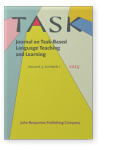Vol. 3:1 (2023) ► pp.28–73
Modelling plurilingual instruction through a crosslinguistic-communicative task sequence
A developmental study
This study aims to bridge the gap between ‘communicative’ and ‘plurilingual’ approaches, by providing a means for teachers to integrate learners’ plurilingual repertoires when teaching an additional language (Lx). We developed a model of crosslinguistic instruction embedded within the task-based language teaching approach. It consists of a 4 stages task sequence: input-based task, crosslinguistic consciousness-raising task, output-based task, and recap of the sequence. An iterative process of field testing and analysis (Harvey & Loiselle, 2009) allowed us to refine the model: researchers in-depth analysis (functional field test), implementation of the model in Lx classrooms (empirical field test) and experts assessment (second functional field test). Participant perceptions and evaluations provide an overview of their appreciation of different aspects, which lead to the current version of the model.
Article outline
- Introduction
- Conceptual framework: TBLT
- Plurilingualism
- Intersection of TSLT and plurilingual practices
- Research objectives
- Methodology
- Repository: Elaboration of the model
- Task sequence: Presentation of the model
- Data collection: Validation of the model
- Results and interpretation
- Prototype 1
- Empirical field test
- Results obtained for Stage 1 – Consciousness-raising task (CRT) (IBT + CCRT in the current version)
- Results obtained for Stage 2 – Communicative activity (OBT + RSCR in the current version)
- Second functional field test
- Positive comments
- Constructive comments
- Discussion and conclusion
- Acknowledgements
- Notes
-
References
